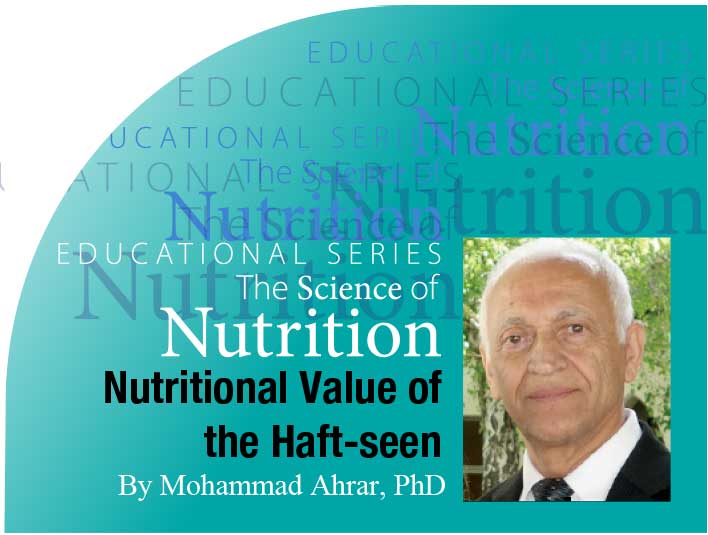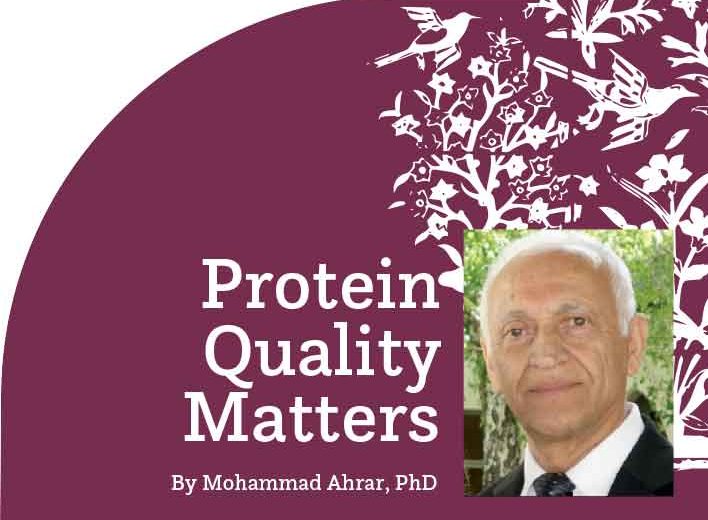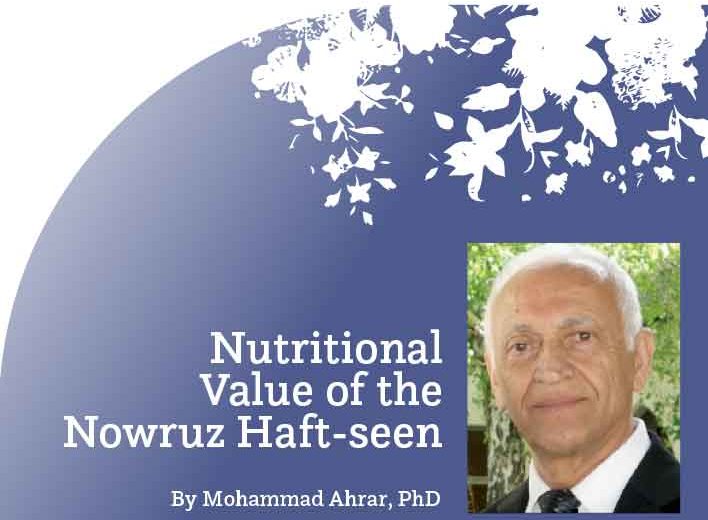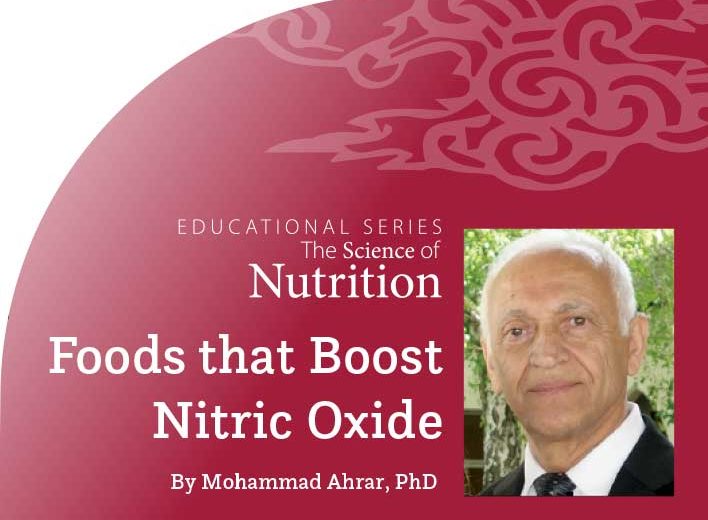By Mohammad Ahrar, PhD
Introduction
There are certain natural elements on the Nowruz table that define a haft-seen whose seven names all start with the letter “s,” such as sib (apple). The haft-seen table is also decorated with other food items such as colored eggs, bread, and dried fruit. Although each item symbolizes a concept in Persian culture, some items on the haft-seen table indeed have great nutritional value. To conserve space, in this article, we will review the nutritional value of some of the items. 
Seer (Garlic)
Seer is used in most Iranian dishes for its special taste and, more importantly, for its nutritional value.
Vitamins and minerals One clove (about 3 grams) of raw garlic provides 1.2 milligrams (mg) of vitamin B6 and a substantial amount of other B vitamins, vitamin C, and vitamin K. Garlic also provides necessary minerals for the body, including zinc, iron, potassium, and magnesium. It is also an excellent source of phosphorus, calcium, manganese, copper, and selenium.
Boosts energy production The phosphorus content of garlic plays a major role in energy production. Adenosine Triphosphate (ATP), referred to as the energy of life, consists of 3 phosphate groups. Without ATP, no living organisms can survive.
Immune system Garlic is known to boost the function of the immune system. Studies have found that a daily garlic supplement reduced the number of colds by 63% compared to a placebo.
Blood pressure High doses of garlic may reduce blood pressure for those with known hypertension.
Antioxidant property Garlic contains antioxidants that support the body’s protective mechanisms against oxidative damage from free radicals. Most of the health benefits of garlic are due to the presence of sulfur compounds that exert potent biological effects on the body cells. At high doses, the sulfur compounds in garlic have been shown to protect against organ damage from heavy metal toxicity. Other compounds that may play a role in garlic’s health benefits include diallyl disulfide and allicin.
Alzheimer’s risk prevention The combined effects of garlic on reducing cholesterol and blood pressure, as well as its antioxidant properties, may help reduce the risk of common brain diseases like Alzheimer’s disease and dementia.
Limitations of use The sulfurous compounds in garlic make it, well, smelly for daily use. The diallyl disulfide in garlic is decomposed in the human body into other compounds such as allyl methyl sulfide, which is then absorbed into the bloodstream and exits the body through the lung and skin. Although some studies suggest drinking milk or chewing chicory, celery, parsley, mint leaves, and peppermint can reduce garlic breath, it seems that taking a small amount of them cannot help much.
Note As garlic and many other underground bulbs and tubers concentrate nutrients, they may also concentrate toxins and pesticides. For this reason, organic onions, beets, turnips, potatoes, and similar food products may be preferable.
Serkeh (Vinegar)
The word vinegar derives from the French “vin aigre” or sour wine. When fruits are fermented in anaerobic conditions (in the absence of oxygen), they turn into wine. Vinegar is produced as a result of the fermentation of sugar-containing fruits in aerobic conditions (presence of oxygen), during which the glucose in fruits is converted to acetic acid which gives the vinegar a sour taste. Acetic acid is naturally produced in the body and used to produce energy during the energy cycle in the cells. Apple cider vinegar is a common form of vinegar in markets, produced as a mixture of acetic acid and water.
Benefits of vinegar The use of vinegar has been traced back to 5,000 B.C.E. in Babylon as a medicine, a preservative, and a drink to boost strength and promote wellness. Early records describe vinegar for medicinal purposes, as a digestive aid, and as a treatment for cough in conjunction with honey.
Blood sugar control Studies involving both diabetic and nondiabetic individuals suggest that adding two teaspoons of vinegar to a meal may improve blood sugar control by about 20 percent.
Ovarian function Daily intake of one tablespoon of apple cider vinegar may improve blood flow to reproductive organs and restore ovarian function in postmenopausal women.
Blood pressure Studies suggest that the daily consumption of a tablespoon of vinegar can lower blood pressure.
Acid reflux Besides the common use of a variety of vinegar products in salads and other foods, some sources indicate that vinegar can be useful in addressing acid reflux and heartburn. The reason may be due to the fact that acetic acid is a weak organic acid that can buffer the strong hydrochloric acid of the stomach, which is an inorganic acid.
Note The term “organic” here is different than used when referring to organic foods. Organic molecules are defined as chemical compounds that contain carbon. Please be advised that regular consumption of vinegar can cause tooth erosion or decrease potassium in blood to hazardous levels. Vinegar may also interact with medication taken by diabetic people, so please consult with your doctor if you are regularly consuming vinegar.
Samanu (Wheat Paste)
Samanu is an important food item traditionally used on the haft-seen table. Samanu is a wheat grain that is usually soaked for 6 to 7 days and blended with some water to liquefy/puree. The mix will be heated at low temperatures and constantly stirred for hours until the water is evaporated. No sugar or salt is added to the mix. Because samanu is mostly a carbohydrate, different types of nuts such as walnuts or hazelnuts are often added to the mixture to add some protein to the product.
From tasteless grain to sweet treat During wheat germination, some chemical reactions occur in the growing cells and new compounds such as enzymes are synthesized in the sprout. One of the enzymes produced is amylase, which is responsible for the breakdown of complex carbohydrates into simple sugars. During the process of making samanu, some enzymes including amylase are activated at low temperatures (because high temperatures destroy enzymes), and the active amylase breaks down the tasteless starch into disaccharide maltose, which has a mild sweet taste.
Nutritional value During wheat germination, new nutrients such as vitamins, proteins, and enzymes are synthesized in the germinative sprout. Samanu contains protein and is rich in vitamin B6. It is also a good source of iron, phosphorus, zinc, selenium, magnesium, copper, and potassium. The calorie content of samanu is not great; it has a medium calorie density of about 77 Calories per ounce.
Digestion of samanu in the body When carbohydrate-rich foods such as samanu are consumed, the enzyme amylase, produced by the pancreas (and sometimes by the salivary glands), breaks down the more complex molecules into simple sugars, mainly glucose, for absorption.
Sumac (Somagh)
The sumac plant, which belongs to the same family as cashews, has 35 varieties. To make the coarse sumac powder we are familiar with, the deep purplish-red berries of Persian sumac are dried and ground. Sumac is a popular ingredient added to some Iranian foods to enhance flavor and taste, but it is not considered a main food. In some Mediterranean and Middle Eastern cuisine, sumac is used therapeutically in herbal medicine practices.
Nutrients Research suggests that sumac contains trace amounts of several essential nutrients, including vitamins C, B6, B1, and B2. Dried sumac also contains carbs, fat, and some protein. The majority of the fat in sumac contains essential fatty acids, namely oleic acid and linoleic acid, which are associated with heart health and healthy skin. However, probably the most important nutritional value of sumac is its antioxidant power.
Antioxidant properties Sumac contains a wide array of chemical compounds with potent antioxidant activity, including tannins, anthocyanins, and flavonoids. Experts believe this may be the primary reason for sumac’s broad therapeutic potential. Antioxidants in foods such as sumac may play a role in reducing inflammation, and may help prevent inflammatory illnesses such as heart disease and some forms of cancer.
Lowering blood sugar Research suggests sumac may be an effective tool for managing blood sugar in people with type 2 diabetes by promoting balanced blood sugar. Please check with your doctor to develop a comprehensive plan to treat your diabetes.
Summary
Many items on the haft-seen table have nutritional value. Raw seer (garlic) provides a variety of vitamins, minerals, and antioxidants that have health benefits. Serkeh (vinegar) has medicinal purposes as a remedy for cough (plus honey), weight control, and blood sugar and blood pressure control. Samanu is a low-calorie food that contains protein, vitamin B6, and many essential minerals. And sumac, which has high antioxidant properties, contains trace amounts of several essential nutrients, including vitamins C, B6, B1, B2, and essential fatty acids. Although these items are consumed in small quantities and should not be considered the main source of nutrients in diets, it’s clear the foods of the haft-seen are healthy ones!
Selected references:
https://www.healthline.com/nutrition/11-proven-health-benefits-of-garlic#TOC_TITLE_HDR_3
https://nutritionfacts.org/topics/vinegar/
https://www.livestrong.com/article/21611-nutritional-value-vinegar/
https://en.wikipedia.org/wiki/Nowruz
https://en.wikipedia.org/wiki/Garlic_breath#
https://www.healthline.com/nutrition/raw-sprouts#TOC_TITLE_HDR_3

















